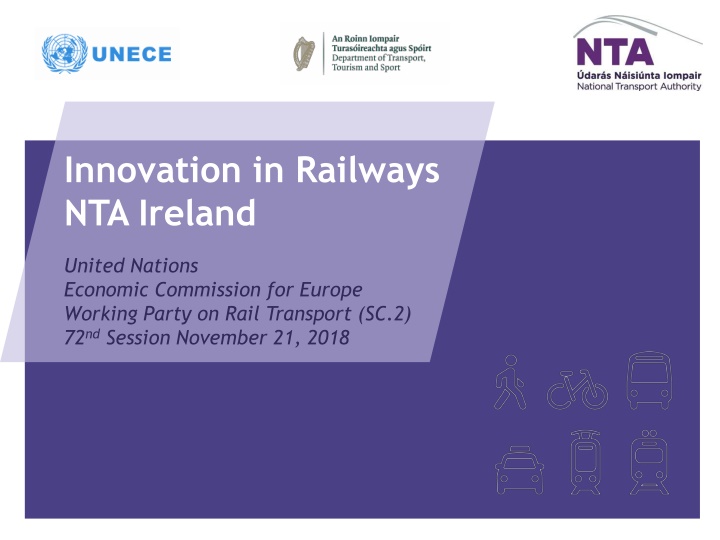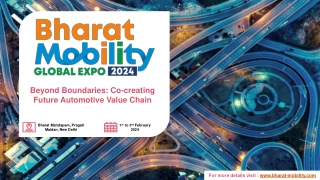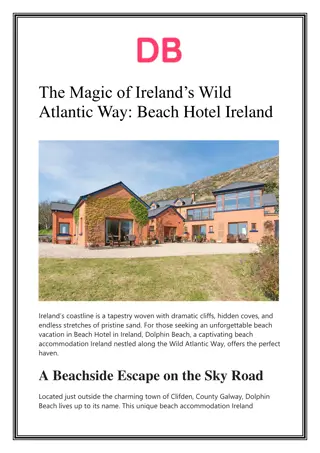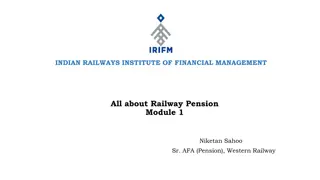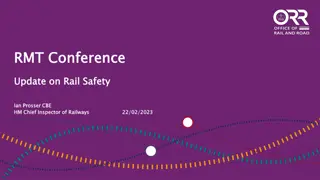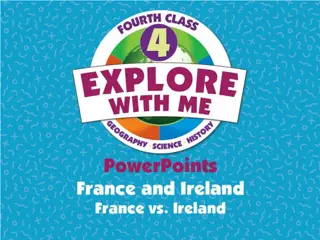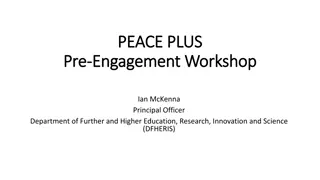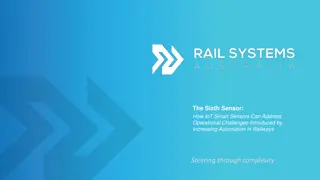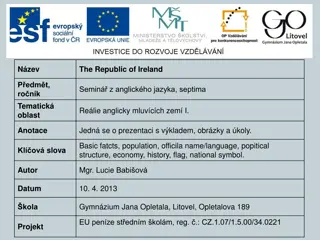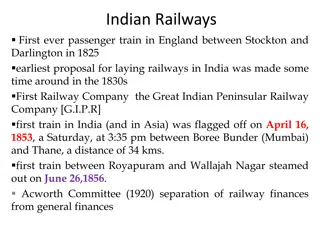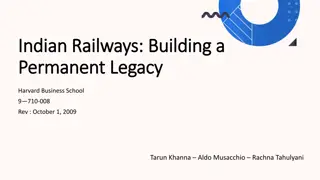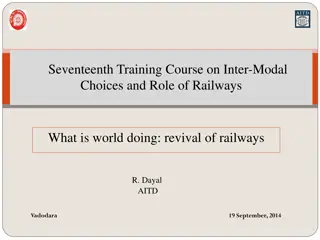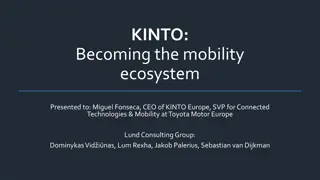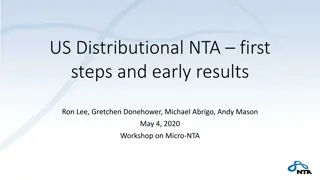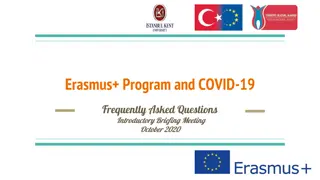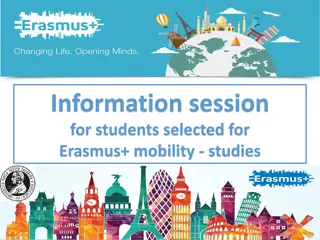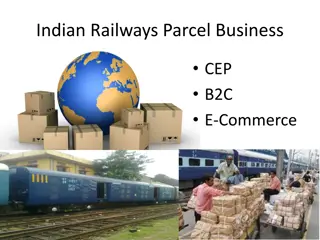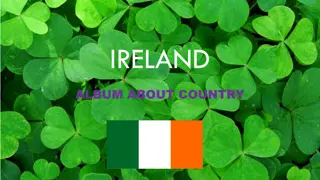Innovation in Railways: NTA Ireland's Role in Future Mobility
National Transport Authority (NTA) of Ireland is at the forefront of driving innovation in public transport, funding projects like Luas light rail and Bus Connects. NTA's mission is to provide sustainable and high-quality transport services connecting people across Ireland. As public transport evolves to meet growing demands, NTA is creating a Mobility Platform to facilitate multiple service providers and innovative business models, adapting to the changing landscape of public mobility.
Download Presentation

Please find below an Image/Link to download the presentation.
The content on the website is provided AS IS for your information and personal use only. It may not be sold, licensed, or shared on other websites without obtaining consent from the author.If you encounter any issues during the download, it is possible that the publisher has removed the file from their server.
You are allowed to download the files provided on this website for personal or commercial use, subject to the condition that they are used lawfully. All files are the property of their respective owners.
The content on the website is provided AS IS for your information and personal use only. It may not be sold, licensed, or shared on other websites without obtaining consent from the author.
E N D
Presentation Transcript
Innovation in Railways NTA Ireland United Nations Economic Commission for Europe Working Party on Rail Transport (SC.2) 72nd Session November 21, 2018
NTA - National Transport Authority of Ireland National Transport Authority (NTA) is an Irish government agency under the responsibility of the Department of Transport Tourism and Sport. NTA has responsibility for securing the provision of public passenger land transport services, including bus and rail services by Bus ireann, Dublin Bus, Go Ahead, Luas (light rail) and Irish Rail (heavy rail). Licenced Private Operators
Capital Investment Capital Projects: NTA funds investment in public transport: Luas light rail Cross City project MetroLink new metro system Bus Connects bus network expansion DART electrified heavy rail expansion programme Leap Card integrated multi-modal multi-operator smart card ticketing system
NTAs Mission Mission Statement: To provide high quality, accessible, sustainable public transport connecting people across Ireland
Evolution of Public Transport Public Transport has to evolve: Congestion is increasing and is not sustainable Environmental standards requires new approaches Growing acceptance that the future of urban transit includes other forms of mobility from autonomous vehicles through to car sharing/ride sharing Smartphones and Mobile apps are creating new expectations Mobility As A Service (MaaS) is an increasingly popular concept So what is the role of NTA in the future of mobility?
Creating a Mobility Platform To achieve our mission: NTA s role is to facilitate (and create where necessary) an environment where: Multiple mobility service providers can co-exist, both publicly and privately run Different service providers can be integrated innovative business models can be catered for Revenue assurance can be provided via appropriate governance and regulatory oversight arrangements Mobility-As-A-Service (MaaS) will change how public transport is delivered and consumed, and MaaS will evolve as the infrastructure develops Innovative new business models and mobility services will emerge if the conditions are right
How NTA will approach this Ticketing as a catalyst: NTA will use a nationwide account based ticketing system as the catalyst for a Total Mobility Solution Providing for integration and convergence of mobile ticketing, with Enhanced national journey planning applications and real time information systems, Single sign-on system for customer accounts, and Comprehensive API s made available to third parties All working towards a converged mobile app and systems that provides a platform for co-existence of public & private mobility solutions new business models, new pricing models, new sales channels
Future Total Mobility Solution Across the Country using a Single Integrated Platform NTA will open up the opportunities for a consumer to get a tram or bus to the city centre, take a city bike to the train station, take train to a regional city and then complete their final leg using a Go Car, including paying for parking at the final destination all using a single travel entitlement, with real-time updates as they travel and automated route recalculation if necessary, providing best value to the customer across both public and private transport providers.
Achieving the Total Mobility Solution A Platform for Mobility As A Service (MAAS): By providing a platform to allow public and private mobility offerings to co-exist, and NTA intends to facilitate innovation in the mobility market and beyond By providing/facilitating a single integrated platform customers can seamlessly utilise the various modes of transport, both public and private Covering from door-to-door, from the first kilometre to last kilometre Providing for Cross-Border integration using a commonly accepted token Creating a governance structure to provide revenue assurance for mobility service providers
Key Principles for Future Mobility Solution Key Principles: Smartphones will be central to a successful mobility transformation, and is the main driver behind the transformation of the mobility landscape - Car Sharing, Bike Hire, Ride sharing etc. Accessibility access has to be simple and frictionless. Customers should not have to check multiple websites/apps for ticketing information Integrated information - can no longer be standalone apps or systems for journey planning or ticketing or real time information or payment, now have to centralise across public and private providers Integrated services joint mobility offerings, covering from door-to-door, including the first Kilometre and last Kilometre will be important, across both public and private mobility providers
Steps to achieve the NTA Objective In progress: NTA has already linked Leap Card with Dublin Bikes (bike hire) and Go Car (car sharing) New ticketing system to deliver greater choice for customers - Choice of payment method Integration with private mobility providers Choice of ticketing media (proof of entitlement to travel) Single-sign-on system being implemented Convergence of apps being planned - national journey planner, real-time passenger information and ticketing APIs to link with third party service providers included in all procurements
Steps to achieve the NTA Objective Possible Next Steps: Linkup with Car Parking for Park and Ride ticketing/payments Digital Proof of Entitlement to prove eligibility for certain services and/or discounted prices Enable transport operators to offer products integrated with third parties Migrate from current card based ticketing (Leap Card) to new nationwide account based ticketing
Policy and Regulation Current Status: Not aware of any national frameworks specifically defining direction for MaaS or role in any future Smart Cities Some relevant EU legislation (multi-modal travel information services etc.) The introduction of defined policies and regulations should help drive future innovation in this area good governance around revenue allocation likely to be critical Collaboration between government authorities and private agencies and technology partners would benefit from clear policies and regulations
Thank you for your time Questions: Barry.Dorgan@nationaltransport.ie
